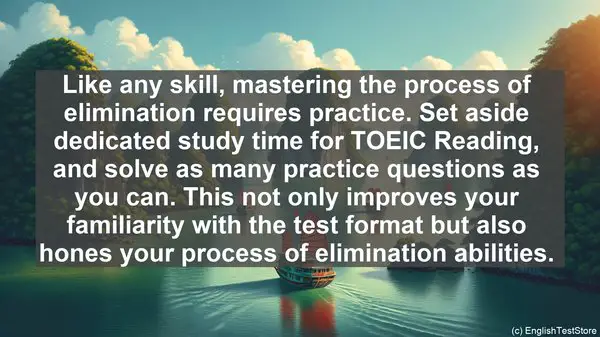Introduction: The Power of Process of Elimination
Welcome to another TOEIC Reading video. Today, we’ll be diving deep into the process of elimination technique. It’s not just a strategy; it’s a powerful tool that can significantly improve your accuracy and speed in the TOEIC Reading section.

1. Read the Question First
Before even glancing at the answer options, read the question carefully. This will give you a clear idea of what you need to look for in the passage. It’s a small step, but it can save you valuable time and help you focus on the relevant information.
2. Identify Keywords
Once you start reading the passage, keep an eye out for keywords related to the question. These can be specific terms, names, or even synonyms. By identifying these keywords, you can quickly locate the relevant section and eliminate irrelevant options.
3. Be Wary of Extreme Language
Answer options with extreme language like ‘always,’ ‘never,’ or ‘completely’ are often incorrect. The TOEIC test aims for accuracy, so it’s rare to find absolute statements. If you come across such options, consider eliminating them.
4. Look for Qualifiers
On the flip side, options with qualifiers like ‘sometimes,’ ‘usually,’ or ‘often’ are more likely to be correct. These qualifiers indicate a level of uncertainty, which aligns with the TOEIC’s objective of testing practical English usage.
5. Use the Passage Structure
The TOEIC Reading passages often have a logical structure, with information presented in a specific order. If the question refers to a particular part of the passage, check the sentences before and after it. This contextual information can guide you towards the correct answer.
6. Apply the ‘True, False, Not Given’ Technique
For certain question types, like ‘True, False, Not Given,’ it’s helpful to approach them as a process of elimination. Start by eliminating options that are clearly false, and then carefully consider the remaining choices. This systematic approach can prevent confusion and improve accuracy.
7. Watch out for ‘Trap’ Options
The test makers are experts at creating ‘trap’ options that seem plausible but are ultimately incorrect. These options often contain information that is slightly different from what’s stated in the passage. So, always double-check and compare the options with the passage before making a decision.
8. Don’t Overthink
Sometimes, the correct answer is more straightforward than it seems. Overthinking can lead to confusion and even choosing the wrong option. Trust your understanding of the passage and the information provided.
9. Use Process of Elimination for Multiple-choice Questions
Process of elimination is particularly useful for multiple-choice questions. By eliminating even one or two options, you increase your chances of selecting the correct answer. Remember, you don’t always have to find the ‘perfect’ answer; you just need to find the most reasonable one.
10. Practice, Practice, Practice
Like any skill, mastering the process of elimination requires practice. Set aside dedicated study time for TOEIC Reading, and solve as many practice questions as you can. This not only improves your familiarity with the test format but also hones your process of elimination abilities.

